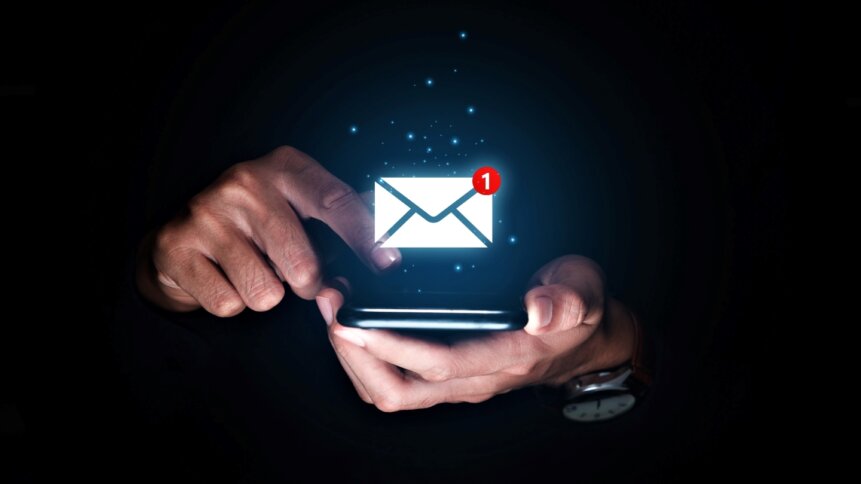Business email optimization: AI-powered sales enablement

|
Getting your Trinity Audio player ready...
|
ChatGPT has got the world thinking about using artificial intelligence (AI) to generate all kinds of text. But chances are high that you’ve been exposed to AI-generated messages long before ChatGPT hit the scene in late 2022. In fact, to find some great examples, you might want to check your inbox. AI-powered sales enablement has made great strides in business email optimization.
Compare and contrast
In the past, business email optimization would involve comparing messages against a checklist of best practices. Guidance included sentence length, word count, and other pointers towards whether recipients would respond well to messages. There are ‘go-to’ copywriting formulas to lean on too. Classics include PAS – Pain, Agitate, Solve – or PASO, if the writer includes an outcome. And the AIDA model, which stands for Attention, Interest, Desire, and Action. In this case, each term is linked to steps in the customer buying journey, to make text – such as an email message – resonate with its target audience.
With PASO, the goal is to stir things up around a customer pain point and, importantly, offer clients a solution that leads to an appealing outcome. Having a structure to base your business emails around can be helpful, but it’s certainly not a game-changer. Hubspot’s Amanda Sellers points out that the principles behind the AIDA model can be traced way back to 1898.
What’s making the difference today in AI-powered sales enablement is being able to automate this process. Tools such as Jasper.ai let users choose from a wide range of writing models and formulas and automatically generate business email suggestions within seconds. Algorithms can be prompted with topics and recommendations on the tone of voice to be applied, which adds up to a step change in business email optimization. And there’s more.
Meet your new business coach
Not only will AI writers help users to compose and sharpen their sales correspondence, tools can double as a business coach as well. Lavender – a popular AI solution for business email optimization – includes a helpful ‘sales email assistant’. The feature analyzes and scores each email, highlighting areas that need work, and guiding users on how to improve their messaging, as well as recognizing which portions are ready and likely to appeal to readers.
Lavender’s team comments that recipients are much more likely to open emails on their mobile, glancing at the headlines for just 3 seconds before deciding whether to proceed or delete. Given how critical business email performance on smartphones and other mobile devices has become, AI-powered sales enablement tools often include mobile-specific parameters.
Business coaching capabilities built into AI writing apps allow sales teams to monitor the open rate and reply rate of the emails sent. They can also track writing time, to see how much time is saved by using AI to compose email correspondence. There’s a lot of flexibility in how AI writing apps can be used. And different users will want to work in different ways.
For example, rather than feeding the system with prompts and other parameters, writing aids can keep an eye on things as the user types. Business email optimization apps can provide a welcome helping hand, much like how popular spell-checkers and writing aids such as Grammarly are able to clean up and improve the readability of text on the go.
AI writing tool providers
In the case of AI-powered sales enablement, business email optimization apps – which can begin writing an email from just a few bullet points – won’t just correct spelling and grammar, they’ll strengthen the messaging too. Lavender can aggregate updates on potential prospects gathered from the web, and use the information to personalize the composed text to make it more impactful. And if the number of companies offering AI-based business email optimization is a measure of how significant these writing tools can be to users, it’s worth listing out some examples of providers operating in this space.
- Smartwriter – stats show that AI-generated emails can get 8x more replies, according to the firm.
- Flowrite – includes a chrome extension that allows the AI email generator to boost productivity on websites such as gmail, LinkedIn, and Slack.
- Wordhero –an AI-powered writing tool built using GPT-3 (an autoregressive language model) and featuring proprietary machine learning technology.
- Rtyr – used by content writers based at firms such as Adidas, Dell, Ford, Pfizer, PWC, and Payoneer.
- ai – can reduce the time taken to write high-converting emails from hours to minutes, according to the developers. Clients include Microsoft, Ebay, and Nestle.
- SHAKEspeare – provided by sales enablement and automation software firm, Mailshake, the AI writer has been trained on data from thousands of cold email campaigns to maximize copy performance.
- Compose AI – backed by start up accelerator, Y-Combinator, Compose AI’s tool can write full email messages from just a few words, and quickly rephrase highlighted sentences.
- Hypotenuse AI – an AI copywriter that can incorporate details such as audience description, brand information, and product or service specifications into its text generation algorithm.
- io – features an AI helper for LinkedIn that can help users to quickly generate new posts on the popular employment-focused social media platform.
- Writecream – includes ChatGenie, which combines ChatGPT 2.0 with the power of Google Search to overcome the current limitations of the wildly popular ChatGPT AI chatbot.
And this is just a selection of the wide range of AI writing tools that have led to a step change in business email optimization. Writing business emails will never be the same again.









